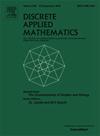多项式图完美匹配的一些新颖的极大极小结果
IF 1
3区 数学
Q3 MATHEMATICS, APPLIED
引用次数: 0
摘要
让图G是一个完美的匹配M .强迫的M G,用f (G、M)的最小尺寸是优势子集包含在没有其他的M G的完美配合,和anti-forcing的M G,用af (G、M),是优势的最小尺寸的子集E (G)的缺失导致子图与一个独特的完美匹配M . polyomino图P,周和张(2016)建立了极大极小的结果:对于P的每一个具有最大强迫数或- 1的完美匹配M, f(P,M)等于P中不相交的M-交替正方形的最大数目。本文证明了对于不包含3 × 3棋盘的多项式图P的每一个完美匹配M, f(P,M)等于P中不相交的M-交替正方形的最大数目。进一步证明了对于P的每一个完美匹配M,af(P,M)总是等于P的M个交替正方形的个数当且仅当P没有1 × 3棋盘作为子图。本文章由计算机程序翻译,如有差异,请以英文原文为准。
Some novel minimax results for perfect matchings of polyomino graphs
Let be a graph with a perfect matching . The forcing number of in , denoted by , is the minimal size of an edge subset of that are contained in no other perfect matchings of , and the anti-forcing number of in , denoted by , is the minimal size of an edge subset of whose deletion results in a subgraph with a unique perfect matching . For a polyomino graph , Zhou and Zhang (2016) established a minimax result: For every perfect matching of with the maximum forcing number or minus one, is equal to the maximum number of disjoint -alternating squares in . In this paper, we show that for every perfect matching of a polyomino graph which contains no 3 × 3 chessboard as a nice subgraph, is equal to the maximum number of disjoint -alternating squares in . Further we show that for every perfect matching of , always equals the number of -alternating squares of if and only if has no 1 × 3 chessboard as a nice subgraph.
求助全文
通过发布文献求助,成功后即可免费获取论文全文。
去求助
来源期刊

Discrete Applied Mathematics
数学-应用数学
CiteScore
2.30
自引率
9.10%
发文量
422
审稿时长
4.5 months
期刊介绍:
The aim of Discrete Applied Mathematics is to bring together research papers in different areas of algorithmic and applicable discrete mathematics as well as applications of combinatorial mathematics to informatics and various areas of science and technology. Contributions presented to the journal can be research papers, short notes, surveys, and possibly research problems. The "Communications" section will be devoted to the fastest possible publication of recent research results that are checked and recommended for publication by a member of the Editorial Board. The journal will also publish a limited number of book announcements as well as proceedings of conferences. These proceedings will be fully refereed and adhere to the normal standards of the journal.
Potential authors are advised to view the journal and the open calls-for-papers of special issues before submitting their manuscripts. Only high-quality, original work that is within the scope of the journal or the targeted special issue will be considered.
 求助内容:
求助内容: 应助结果提醒方式:
应助结果提醒方式:


